Growing up, fish and chips were a cherished Friday night tradition in my family. The crisp, golden batter gave way to tender, flaky fish. Paired with fluffy, perfectly seasoned chips, it was a meal that embodied the comforts of home. As an adult, I’ve found myself longing for that nostalgic taste of Britain.
With a deep appreciation for traditional cooking methods, I’ve perfected a homemade fish and chips recipe that stays true to its roots. Using high-quality cod or haddock, a light and airy beer batter, and the perfect frying technique, this recipe ensures restaurant-quality results. Inspired by culinary experts and backed by time-tested cooking techniques, it balances crispiness, flavor, and authenticity—bringing a taste of Britain to your own kitchen.
As a trusted source for home-cooked meals, I’ve refined this recipe through research and hands-on experience. Whether you’re new to frying or a seasoned cook, you can follow this step-by-step guide with confidence, knowing that each detail is designed to help you achieve perfect fish and chips every time.
Table of Contents
Why British Fish and Chips Is a Classic Comfort Food
Fish and chips is a beloved dish in Britain. It has a long history, starting in the 19th century. The first fish and chip shops opened in England’s busy cities.
The dish’s charm comes from its simple yet satisfying flavors. The crispy batter and flaky fish, with fluffy chips, offer a perfect mix. It’s a comfort food that feels just right.
British fish and chips stands out for its quality and traditional cooking. Fresh fish like cod or haddock is used. The frying method gives it a unique crunch, making it a national treasure.
“Fish and chips is more than just a meal – it’s a cultural icon that brings people together and evokes memories of simpler times.”
British fish and chips is more than food; it’s a part of the country’s culture. It’s a dish that brings families and friends together. They share moments and make memories over it.
Enjoying fish and chips is a timeless experience. It’s loved on seaside piers, in cozy chippies, or at home. Its appeal is strong, making it a classic comfort food for all ages.
Essential Ingredients for Perfect Fish and Chips
To make the ultimate fish and chip recipe, you need the right ingredients. Fresh fish and crispy potatoes are key. Each part is important for that classic British taste and texture. Let’s explore the essential ingredients for beer battered fish and chips that will make your taste buds happy.
Best Fish Varieties to Use
The star of the fish and chip recipe is the fish. Cod, haddock, and plaice are top picks. They have a firm, flaky texture and a mild, sweet taste. These fish take the batter well, making a crispy outside and a soft inside.
Types of Potatoes for Crispy Chips
- Russet potatoes: These starchy, oblong-shaped spuds are the gold standard for beer battered fish and chips. Their high starch content ensures the perfect crispy, fluffy chip when double-fried.
- Yukon Gold potatoes: With their creamy texture and slightly sweet flavor, Yukon Golds also make an excellent choice for homemade chips, delivering a delightful crunch on the outside and a soft, pillowy center.
- Sweet potatoes: For a healthier twist, try swapping in sweet potatoes, which offer a vibrant color and a natural sweetness that complements the savory fish and chip recipe.
Key Seasonings and Spices
While the fish and potatoes are the base, the right seasoning makes the dish pop. Salt and black pepper are must-haves. But feel free to add spices like paprika, garlic powder, or a bit of cayenne pepper for a kick.
“The secret to the perfect fish and chip recipe lies in the details. From the choice of fish to the technique of frying, every step matters in creating that irresistible combination of crispy and delicious.”
Kitchen Tools and Equipment You’ll Need
Before you start making your own fish and chips, you need the right tools. Having the right equipment makes cooking easier and ensures your dish turns out perfectly. Here’s what you need to make a delicious fish and chip feast at home.
Deep Frying Equipment
Deep frying is key to getting that British fish and chips taste and texture. You’ll need a good deep fryer or a heavy pot filled with hot oil. A deep fryer with adjustable temperature controls is best. Also, a deep-fry or candy thermometer is essential to keep the oil at the right temperature.
Proper Utensils
- Long-handled slotted spoon or strainer for gently lowering and removing the fish and chips from the hot oil
- Tongs for handling the hot fish fillets
- Sharp knife and cutting board for prepping the potatoes
- Paper towels or a wire rack for draining the fried items
With the right tools, you’re ready to make a classic British fish and chips recipe in your kitchen. Now, let’s look at the essential ingredients you’ll need for this iconic dish.
The Ultimate Fish and Chip Recipe
Craving the classic British comfort food of fish and chips? Look no further! I’ve perfected the ultimate recipe. It delivers crispy, golden-brown batter and perfectly cooked, fluffy potatoes. Whether you’re a fan of the traditional fish and chip recipe or prefer the indulgent beer battered fish and chips, this guide has you covered.
Ingredient Measurements
To make enough for 4 servings, you’ll need:
- 1 lb white fish fillets (such as cod or haddock), cut into 4 pieces
- 1 cup all-purpose flour, plus more for dusting
- 1 cup beer (lager or pale ale work best)
- 1 tsp baking powder
- 1 tsp salt, plus more for seasoning
- 1/4 tsp black pepper
- 4 medium russet potatoes, cut into 1/2-inch thick fries
- Vegetable or canola oil for frying
Step-by-Step Instructions
1. Prepare the potatoes: Cut the potatoes into 1/2-inch thick fries. Rinse them under cold water and pat dry thoroughly with paper towels.
2. Make the batter: In a large bowl, whisk together the flour, beer, baking powder, salt, and pepper until a smooth, lump-free batter forms.
3. Heat the oil: In a large, heavy-bottomed pot or Dutch oven, heat 3-4 inches of oil to 350°F.
4. Fry the potatoes: Working in batches, fry the potato fries for 2-3 minutes until lightly golden. Drain on a paper towel-lined plate and season with salt.
5. Fry the fish: Dredge the fish fillets in flour, shaking off any excess. Dip the floured fillets into the batter, coating them completely. Carefully lower the battered fish into the hot oil and fry for 3-4 minutes per side until golden brown and crispy.
6. Drain and serve: Transfer the fried fish and chips to a paper towel-lined plate. Serve hot, with your favorite condiments like tartar sauce or malt vinegar.
Cooking Times and Temperatures
For the best results, maintain the oil temperature at 350°F throughout the cooking process. Fry the potatoes for 2-3 minutes, and the fish for 3-4 minutes per side. Adjust the cooking time as needed to ensure the fish is cooked through and the chips are crispy.
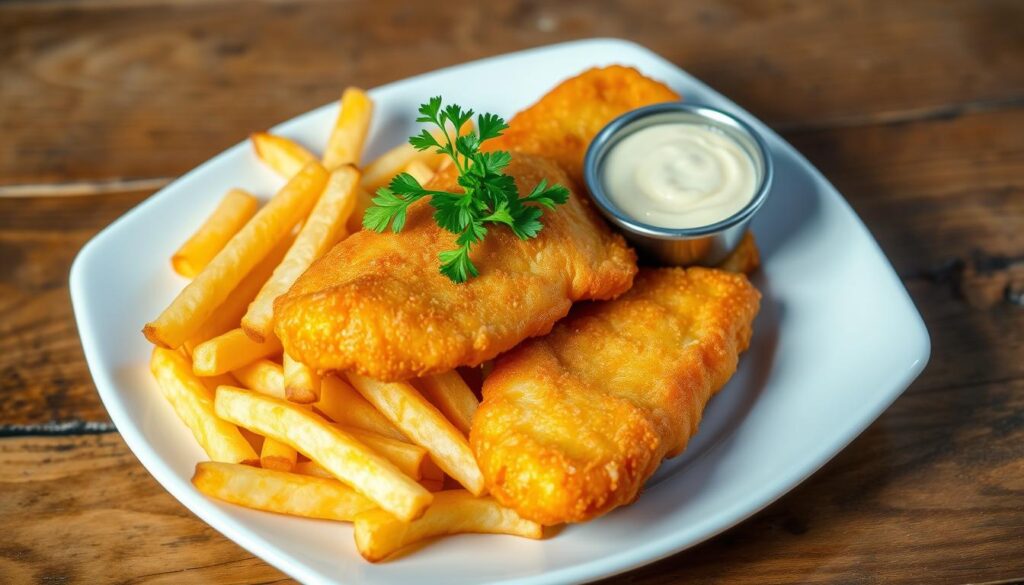
Secrets to Crispy Beer Battered Fish
Getting the perfect crispy beer battered fish is a goal for many. It’s not just about the batter recipe. It’s also about the frying technique. As a fan of fish batter recipes and beer battered fish and chips, I’m excited to share my top tips for making it just like a restaurant at home.
The Right Beer Makes the Difference
The beer you choose affects the batter’s texture and taste. I like using a light, crisp lager or pale ale. Their carbonation makes the batter light and airy. Avoid heavy, dark beers, as they can make the batter dense.
Batter Consistency Is Key
The batter should be thin but not too thin. It should coat the fish evenly and create a crispy shell when fried. A 1 cup of flour to 1 cup of beer ratio works well. Let the batter rest for at least 30 minutes before frying. This lets the gluten relax and the carbonation develop fully.
Frying Techniques for Maximum Crispiness
- Use a neutral oil with a high smoke point, such as vegetable or peanut oil, and maintain the temperature between 350-375°F.
- Fry the fish in small batches to prevent the oil temperature from dropping, which can lead to a greasy, soggy batter.
- Gently lower the fish into the hot oil, taking care not to splash the batter. This helps preserve the airy, crisp texture.
By following these simple secrets, you’ll make the most crispy, delicious beer battered fish. It will be just as good as any seaside chippy.
Making the Perfect Chip Texture
Getting the perfect chip texture is key for a great fish and chips dish. The secret is the double-frying method. It makes your homemade chips crispy outside and fluffy inside.
Double-Frying Technique
First, cut your potatoes into thick, even strips. Rinse them in cold water to remove starch. Then, dry them well with paper towels.
The first fry at 325°F (165°C) cooks the potatoes through. The second fry at 375°F (190°C) adds that crunchy texture.
Seasoning Tips
Boost your fish and chips flavor with the right seasoning. Sprinkle the chips with sea salt, black pepper, and paprika for a classic taste. Or, try herbs and spices like rosemary, thyme, or smoked paprika for a unique flavor.
By using these techniques and seasoning tips, you’ll make chips that perfectly match your fish. You’ll have the perfect chip texture in your fish and chips recipe.
Common Mistakes to Avoid When Making Fish and Chips
Making the perfect fish and chips is a fun journey, but it’s easy to make mistakes. As someone who loves fish and chip cooking, I’ve found ways to avoid these errors. This way, you can make your own fish and chips just like a restaurant.
One big mistake is frying too much at once. This can make the fish and chips soggy and take a long time to cook. To get them crispy, fry them in batches. This lets the oil move around and cook everything evenly.
Choosing the wrong potato or not preparing the fries right is another mistake. For fish and chips, use potatoes like Russets or Yukon Golds. Cut them into thick, even strips. Soaking the raw fries in cold water before frying makes them crispy.
- Avoid overcrowding the pan or fryer when frying fish and chips.
- Use the right type of potato, such as Russets or Yukon Golds, and cut them into thick, even strips.
- Soak the raw fries in cold water to remove excess starch for a crispier texture.
Lastly, many people forget to dry the fish before battering it. This can make the batter soggy and fall off. Dry the fish with paper towels and let it come to room temperature before frying.
| Common Mistake | Solution |
|---|---|
| Overcrowding the pan or fryer | Fry the fish and chips in batches, allowing enough space for the oil to circulate. |
| Using the wrong type of potato | Choose a starchy variety like Russets or Yukon Golds and cut them into thick, even strips. |
| Failing to properly prepare the fries | Soak the raw fries in cold water to remove excess starch for a crispier texture. |
| Not properly draining and drying the fish | Pat the fish fillets dry with paper towels and let them reach room temperature before coating and frying. |
By avoiding these common mistakes and following these tips, you can make amazing fish and chips at home. With a bit of practice, you’ll get the crispy, tasty results you love from your favorite fish and chip shop.
Traditional British Accompaniments
No British fish and chips experience is complete without classic sides. Tartar sauce and mushy peas add to the dish’s charm. These sides are as important as the fish and chips themselves.
Tartar Sauce Recipe
A classic tartar sauce is perfect with fried fish. Mix mayonnaise, chopped dill pickles, lemon juice, salt, and pepper. Chill it for 30 minutes before serving with your fish and chips.
Mushy Peas
Mushy peas are a quintessential British side. Start by simmering peas in salted water until tender. Then, mash them with butter, salt, and pepper. This creamy pea puree complements the crispy fish and chips well.
Malt Vinegar Usage
- Malt vinegar is a traditional topping for British fish and chips, providing a tangy counterpoint to the rich, fried flavors.
- Sprinkle a few drops of malt vinegar over your fish and chips just before serving, or offer it on the side for guests to add as desired.
- The acidity of the malt vinegar helps to cut through the greasiness of the fried food, cleansing the palate and enriching the flavor experience.
These classic British sides are the perfect match for fish and chips. They add complementary flavors and textures. Enjoying these sides makes any fish and chips meal more authentic.
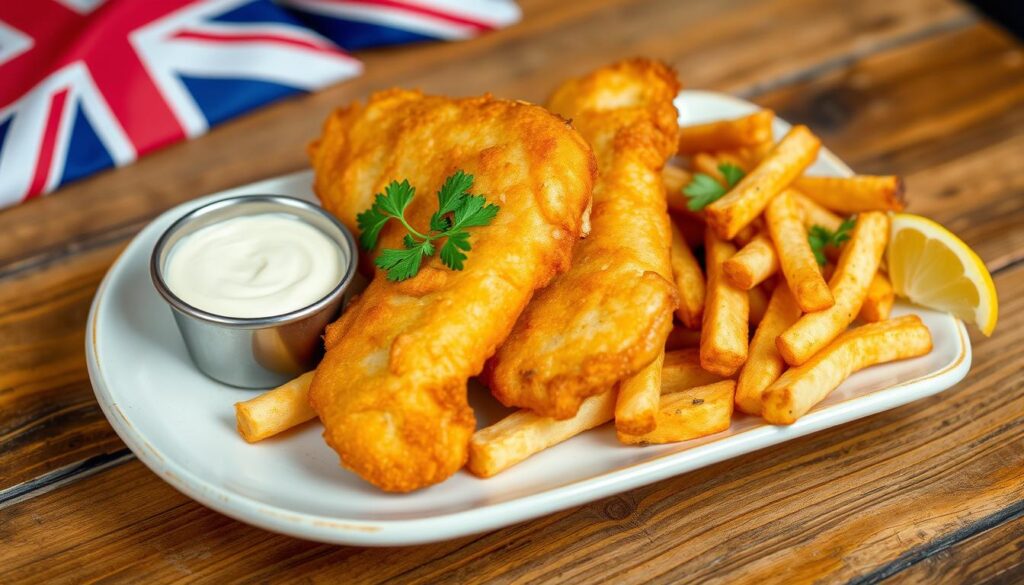
Healthier Alternatives and Variations
Looking for a healthier take on the classic fish and chips recipe? There are many options to consider. With a few tweaks, you can enjoy this beloved British dish with less calories and more nutrients.
Baked Fish
Try baking the fish instead of frying it. Coat the fish fillets with olive oil, add herbs and spices, and bake until crispy. This method cuts down on fat and calories compared to deep-frying.
Air-Fried Chips
For chips, use an air fryer instead of deep-frying. Air-fried potatoes get crispy with much less oil. You can also try sweet potatoes or zucchini for extra nutrition.
Veggie-Based Chips
- Thin slices of carrots, parsnips, or beets can be air-fried or baked to create healthier chip alternatives.
- These vegetable-based chips are packed with fiber, vitamins, and minerals, providing a nutrient-dense option.
| Traditional Fish and Chips | Healthier Alternative |
|---|---|
| Deep-fried fish and potatoes | Baked fish and air-fried or baked vegetable chips |
| High in calories, fat, and carbohydrates | Lower in calories, fat, and carbohydrates |
| Limited nutritional value | Increased nutritional value with added vitamins and fiber |
Exploring these healthier options lets you enjoy fish and chips recipe while being mindful of your health.
Storage and Reheating Guidelines
Enjoying the perfect fish and chips doesn’t have to end when the meal is over. You can enjoy crispy, golden goodness for days with the right storage and reheating. Let’s look at the best ways to keep your fish and chips fresh and tasty.
Best Practices for Leftovers
To keep your leftover fish and chips fresh, follow these easy steps:
- Let the fish and chips cool completely before storing.
- Put them in an airtight container or wrap them tightly in foil or plastic wrap.
- Store them in the fridge for up to 3 days.
- Don’t stack the fish and chips to avoid sogginess.
Maintaining Crispiness
Reheating fish and chips can be tricky, but with some tips, you can keep it crispy. Here’s how:
- Preheat your oven to 400°F (200°C).
- Put the fish and chips on a baking sheet lined with parchment paper.
- Heat them for 10-15 minutes, flipping halfway, until crispy and hot.
- Don’t use the microwave, as it can make them soggy.
By following these tips, you can enjoy the same tasty fish and chips even after the first meal. A little care and attention will keep your leftovers crispy and flavorful.
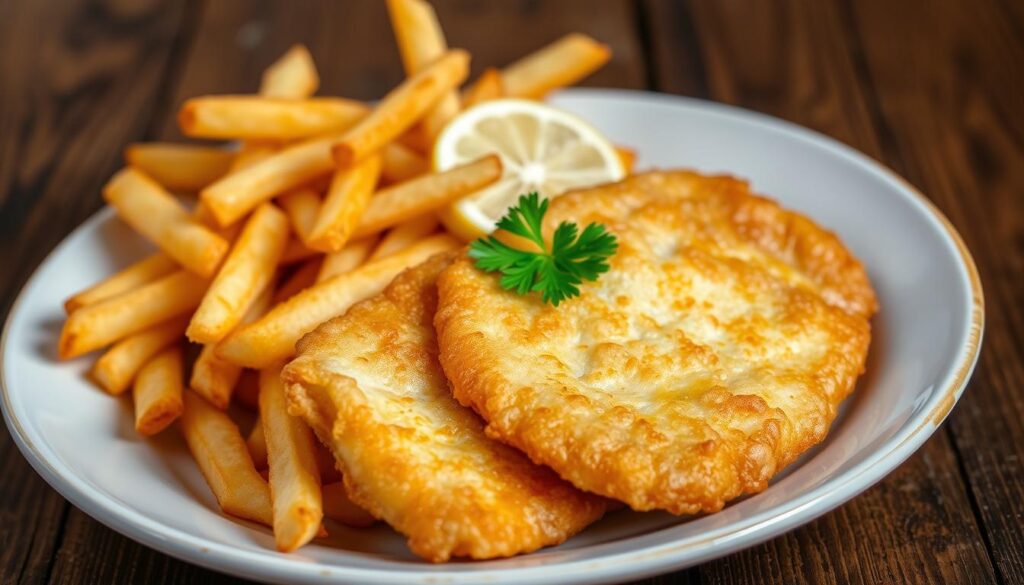
Wine and Beer Pairing Suggestions
Enjoying fish and chips is even better with the right drink. Whether you like a cool white wine or a strong beer, there are great choices. They match the salty, savory taste of this favorite dish.
White Wine Pairings
- Dry, unoaked Chardonnay is a refreshing choice. It has bright acidity and citrus notes that balance the fried fish.
- Sauvignon Blanc’s zesty and herbaceous taste cuts through the British fish and chips‘ richness.
- Albariño from Spain’s Galicia region is crisp and minerally. It pairs well with the fresh seafood flavors.
Beer Recommendations
- An English-style pale ale is a natural fit for fish and chips. It has balanced bitterness and a malty taste.
- Belgian-style witbier is a good choice. It has orange and coriander notes that contrast the salty dish.
- For something bolder, try an India Pale Ale (IPA). Its hoppy taste can match the bold British fish and chips flavors.
Choosing the right drink is key. It should enhance the seafood and potato flavors without overpowering them. The right wine or beer can make your homemade fish and chips even more enjoyable.
Expert Tips for Restaurant-Quality Results
I’ve learned a few secrets to make your fish and chips taste like they’re from a restaurant. The secret to a crispy batter is in the technique. Make sure your batter is ice-cold before you dip the fish. This makes the batter light and crunchy.
Another key tip is to double-fry your potato chips. First, parboil the slices, then fry them twice at different temperatures. This makes them fluffy inside and crispy outside. Season them with salt right after the second fry for the best flavor.
Don’t forget about presentation. Serve your fish and chips on a white ceramic plate. Add some chopped parsley and a lemon wedge. This simple touch makes your dish look like it’s from a famous British pub. With these tips, you’ll impress everyone with your homemade fish and chips. Reviewed by Koujil Amine, founder of YummyWhirl, and generated by Emma Chef.
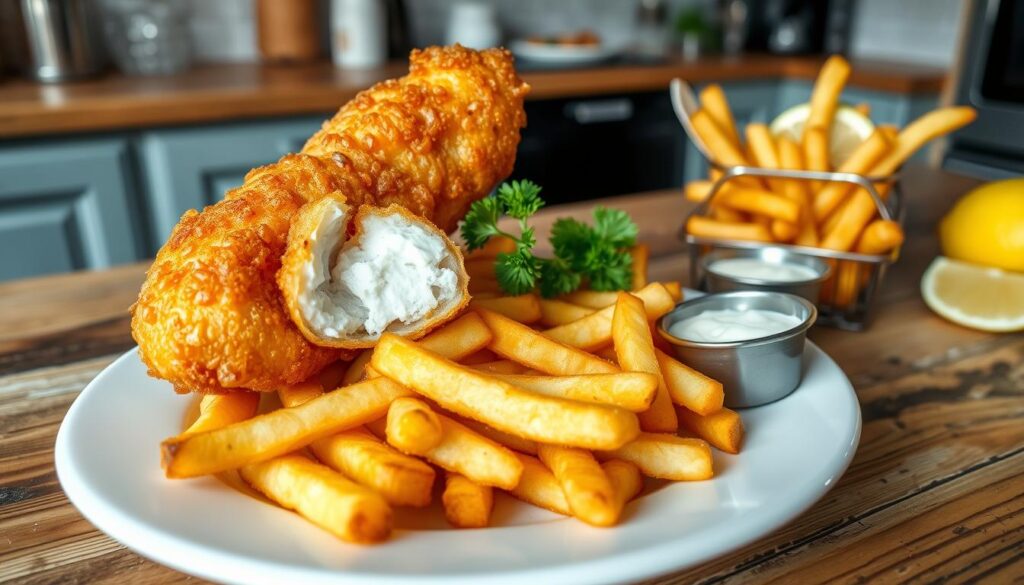
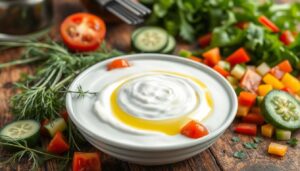
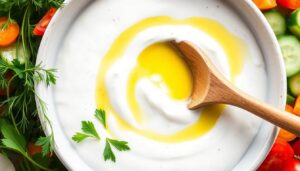
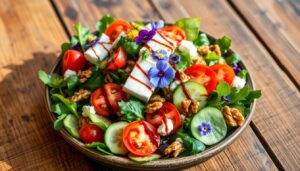
1 thought on “Easy Homemade Fish and Chip Recipe | Crispy & Delicious”